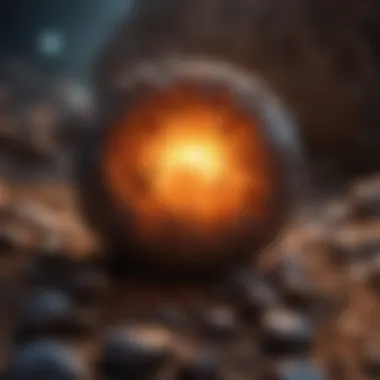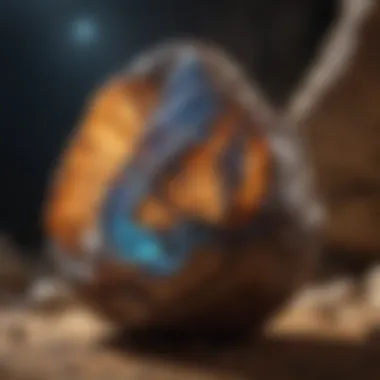Unveiling the Fascinating UV Light Options for Rock and Fossil Collectors


Rock and Fossil Identification
Collecting Tips and Techniques
Collecting rocks and fossils requires adherence to best practices to ensure both a successful collection process and the preservation of specimens. Identifying prime collecting sites involves researching areas known for geological diversity and contacting local geological societies for guidance. When extracting specimens, it is important to do so safely to avoid damaging the specimen or disturbing the natural environment.
Preservation and Display
Preserving rocks and fossils is essential to maintain their integrity and longevity. Techniques such as using consolidants to strengthen fragile specimens and storing them in acid-free paper or boxes can help prevent degradation. Creative display ideas allow collectors to showcase their prized specimens while protecting them from dust and physical harm.
Geological Insights
Exploring geological formations and processes provides valuable insights into the Earth's history. Understanding the historical significance of rocks and fossils sheds light on past environments and climates. Notable discoveries in the field offer glimpses into groundbreaking research and scientific advancements in understanding our planet's geological heritage.
Introduction to UV Lights
In the exploration of UV light options for rock and fossil collectors, understanding the significance of UV lights is paramount. UV lights play a crucial role in enhancing the observation and analysis of geological specimens. By utilizing UV lights, collectors can unveil hidden features and gain insight into the mineral content of rocks and fossils.
Understanding UV Light
Definition of UV Light
UV light, also known as ultraviolet light, is a form of electromagnetic radiation that is invisible to the human eye. This type of light falls outside the visible spectrum, with wavelengths shorter than those of visible light but longer than X-rays. The key characteristic of UV light lies in its ability to cause fluorescence in certain minerals and materials when exposed to it. This property makes UV light a valuable tool for rock and fossil collectors, allowing them to identify and distinguish unique features that may not be visible under regular lighting conditions.
Types of UV Light
There are several types of UV lights available, each with its own unique characteristics and benefits for collectors. Shortwave UV lights, for example, emit UV radiation with wavelengths between 100 to 280 nanometers. These lights are ideal for revealing fluorescence in specific minerals and are commonly used in mineral identification and authentication. On the other hand, longwave UV lights emit radiation within the range of 315 to 400 nanometers, offering a different perspective on fluorescence and mineral analysis. LED UV lights, with their compact size and energy efficiency, have become increasingly popular among collectors for their portability and ease of use.
Importance in Rock and Fossil Collecting


Illuminating Hidden Features
One of the primary roles of UV lights in rock and fossil collecting is to illuminate hidden features that may go unnoticed under normal lighting. Certain minerals exhibit fluorescent properties when exposed to UV light, making it easier to detect subtle details and patterns in rocks and fossils. By using UV lights to uncover these hidden features, collectors can enhance their overall appreciation and understanding of geological specimens.
Identifying Mineral Content
Another critical aspect of UV lights in rock and fossil collecting is their ability to aid in identifying mineral content. Different minerals fluoresce in distinct ways under UV light, allowing collectors to differentiate between various mineral compositions within a specimen. This capability is invaluable for geological analysis, as it enables collectors to make informed assessments of the mineralogy present in rocks and fossils.
Types of UV Lights Available
Shortwave UV Lights
Characteristics and Benefits
Shortwave UV lights are known for their high-energy output, emitting ultraviolet light with wavelengths between 100 to 280 nanometers. One key characteristic of shortwave UV lights is their ability to fluoresce minerals and compounds, making them instrumental in identifying specific mineral content within rocks and fossils. The shortwave spectrum offers precise illumination, allowing collectors to distinguish subtle variations in fluorescence that may indicate unique properties or origins of geological specimens.
Best Applications
Shortwave UV lights are preferred for their ability to highlight fluorescent minerals effectively. Their short wavelength enables the quick and accurate identification of minerals that exhibit fluorescent properties under UV light. This makes shortwave UV lights a popular choice among rock and fossil collectors looking to uncover hidden features of their specimens. Additionally, shortwave UV lights are commonly used in mineralogy, gemology, and paleontology for their precise and detailed fluorescence capabilities.
Longwave UV Lights
Usage and Advantages
Longwave UV lights emit ultraviolet light with longer wavelengths, typically ranging from 315 to 400 nanometers. Their primary advantage lies in their ability to penetrate deeper into specimens, allowing for the detection of fluorescence in minerals that may not react to shortwave UV light. Collectors utilize longwave UV lights to uncover fluorescence in a broader range of minerals, aiding in comprehensive mineral identification and analysis.
Suitable Applications
Longwave UV lights are well-suited for applications where a broader spectrum of fluorescence needs to be examined. Their longer wavelengths make them ideal for detecting fluorescence in minerals that exhibit characteristics not visible under shortwave UV light. Rock and fossil collectors benefit from using longwave UV lights when exploring specimens with diverse mineral compositions, enhancing their ability to identify and differentiate between various mineral types.


LED UV Lights
Features and Benefits
LED UV lights combine the efficiency of light-emitting diodes with the fluorescence-enhancing properties of UV light. One key feature of LED UV lights is their energy efficiency, providing bright illumination while consuming minimal power. Their compact size and durability make them convenient for collectors looking for portable and reliable UV light sources.
Accessibility and Portability
LED UV lights offer enhanced accessibility and portability compared to traditional UV light sources. Their compact design and lightweight construction make them ideal for fieldwork and outdoor excursions. With options for rechargeable batteries, LED UV lights provide extended usage without the need for constant power sources, offering flexibility and convenience to rock and fossil collectors on the go.
Where to Find UV Lights for Sale
In the pursuit of enhancing the experience of rock and fossil collecting, the topic of where to find UV lights for sale stands as a crucial element in aiding collectors. The availability and accessibility of UV lights play a fundamental role in enabling enthusiasts to uncover hidden features and mineral content in their geological specimens. This section delves into the specific elements, benefits, and considerations surrounding the procurement of UV lights.
Local Rock and Fossil Stores
Exploring Nearby Options
Exploring nearby options within local rock and fossil stores offers enthusiasts a convenient and efficient way to access UV lights. The key characteristic of exploring nearby options lies in the proximity to collectors' locations, presenting a time-saving and practical choice. This approach allows enthusiasts to physically inspect the UV lights, ensuring they meet their specific requirements before purchase. The unique feature of exploring nearby options is the immediate availability of expert advice and consultation, enhancing the overall buying experience for collectors.
Benefits of Local Purchase
The benefits of local purchases from rock and fossil stores are multifaceted. By opting for local sources, collectors can establish direct connections with the store owners or experts, fostering a sense of community within the hobby. Additionally, local purchases support small businesses and contribute to the local economy, creating a win-win situation for both collectors and retailers. The unique feature of local purchases lies in the personalized service and tailored recommendations that cater to collectors' individual needs, ensuring a satisfying shopping experience.
Online Retailers
Popular Websites to Explore
Exploring popular websites to acquire UV lights offers collectors a vast array of options to choose from. The key characteristic of popular websites is the extensive range of products available, catering to different budget constraints and preferences. This broad selection provides collectors with the flexibility to compare prices, read reviews, and make informed decisions before finalizing a purchase. The unique feature of popular websites is the convenience of shopping from the comfort of one's home, with the added benefit of doorstep delivery.


Considerations for Online Purchases
When considering online purchases of UV lights, certain factors come into play to ensure a seamless buying process. The key characteristic of considerations for online purchases includes evaluating the reputation and reliability of the website or seller. This scrutiny helps collectors avoid potential scams or the purchase of subpar products. One unique feature of online purchases is the ability to access a global marketplace, allowing collectors to explore unique or specialized UV lights that may not be available locally. However, it is essential for collectors to factor in shipping costs, delivery times, and return policies when making online transactions.
Factors to Consider Before Buying UV Lights
Budget and Quality
Evaluating Price vs. Performance
Evaluating price versus performance is a critical aspect when deciding on UV lights for rock and fossil collections. This comparison allows buyers to balance their budget constraints with the desired level of quality and functionality. Understanding the trade-off between the initial cost and the long-term benefits of a UV light can guide collectors towards selecting a reliable option that meets their expectations. By carefully assessing the features and performance metrics of different models, individuals can ensure they are investing in a product that aligns with their specific needs.
Long-term Durability
Long-term durability plays a significant role in the decision-making process when purchasing UV lights. Collectors seek tools that not only offer immediate utility but also demonstrate longevity and resilience over time. Assessing the construction materials, design robustness, and manufacturer reputation can provide insights into the expected lifespan of a UV light. Considering factors such as maintenance requirements and potential wear and tear can help enthusiasts choose a durable and reliable lighting solution that withstands the rigors of regular use.
Purpose of Use
Professional vs. Recreational Use
Distinguishing between professional and recreational use is essential in the context of UV lights for rock and fossil collecting. Professionals may require advanced features and precision for detailed analysis and documentation, while recreational users prioritize ease of use and versatility for hobbyist endeavors. Understanding the intended application of the UV light helps in selecting a tool that matches the level of performance and sophistication required for specific tasks. By aligning the purpose of use with the capabilities of the UV light, collectors can enhance their overall experience and outcomes in examining geological specimens.
Specific Applications
Exploring the specific applications of UV lights unveils the diverse capabilities and potential uses in rock and fossil collecting. Different lighting wavelengths and intensities cater to distinct purposes such as mineral identification, fluorescence observation, and identifying unique geological features. By considering the specific applications they intend to pursue, collectors can pinpoint the most suitable UV light option that complements their exploration and discovery objectives. Tailoring the choice of UV light to match the intended applications optimizes its effectiveness and utility in enhancing the visual representation and analysis of rocks and fossils.
Portability and Ease of Use
Compactness and Weight
The compactness and weight of a UV light greatly influence its portability and usability during field expeditions or indoor inspections. Collectors value lightweight and easy-to-carry devices that do not compromise on performance or functionality. Assessing the ergonomic design, size, and weight distribution of UV lights enables enthusiasts to select a model that balances portability with robustness. An optimal combination of compactness and weight ensures convenience and maneuverability while exploring diverse geological sites and examining specimens with precision.
Rechargeable vs. Battery-powered
The choice between rechargeable and battery-powered UV lights underscores the importance of energy autonomy and operational flexibility. Rechargeable models offer sustainable power solutions and eliminate the need for frequent battery replacements, making them cost-effective and environmentally friendly. On the other hand, battery-powered options provide instant power availability without the requirement of recharging intervals, ideal for scenarios where access to charging facilities is limited. By evaluating the pros and cons of rechargeable and battery-powered UV lights based on usage patterns and preferences, collectors can select the most suitable power source that aligns with their fieldwork requirements and operational convenience.







